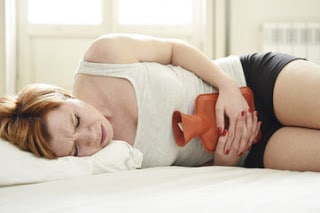
Menstruation is a monthly occurrence for women in which the body sheds the lining of the uterus (womb), which is then passed through a small opening in the cervix and out through the vaginal canal.
Some pain, cramping, and discomfort during menstrual periods is normal. However, excessive pain that causes you to regularly miss work , school or feel very uncomfortable is not normal.
The medical term for painful menstruation is dysmenorrhea.
There are two types of dysmenorrhea :
- Primary dysmenorrhea occurs in women who experience pain just before and during menstruation, but who are otherwise healthy. Women who have had normal periods that later become painful may have secondary dysmenorrhea. This condition is usually accompanied by a problem affecting the uterus or other pelvic organs.
- Secondary dysmenorrhea is characterized by cramping pains that are due to an identifiable medical problem such as endometriosis, uterine fibroids, or pelvic inflammatory disease.
I would talk about primary dysmenorrhea mainly in this article because that’s the common one our girls experience.
Causes of Menstrual Cramps

Menstrual cramps are caused by contractions in the uterus, which is a muscle. The uterus, the hollow, pear-shaped organ where a baby grows, contracts throughout a woman’s menstrual cycle. If the uterus contracts too strongly, it can press against nearby blood vessels, cutting off the supply of oxygen to the muscle tissue of the uterus. Pain results when part of a muscle briefly loses its supply of oxygen.
The following circumstances may make a woman more likely to experience menstrual cramps:
- If she started her first period at an early age (younger than 11 years).
- Her menstrual periods last 5 days or longer.
- She smokes cigarettes
- She has never been pregnant.
- She has female relatives who have menstrual cramps. It can be hereditary.
- Having heavy bleeding with periods
- Having irregular periods
The symptoms of menstrual cramps
Symptoms of menstrual cramps include:
- Dull, throbbing, cramping pain in the lower abdomen
- Pain in the lower back and thighs
- Nausea
- Vomiting
- Sweating
- Dizziness
- Diarrhea
- Loose stools
- Constipation
- Bloating in the belly area
- Headaches
- Lightheadedness – feeling faint.
- Irritability
- Fatigue
Quick Treatment of Menstrual Cramps
- Using a heating pad on your pelvic area or back
- Massaging the abdomen
- Taking a warm bath
- Regular physical exercise
- Eating light and nutritious meals
- Practicing relaxation techniques or yoga
- Taking an anti-inflammatory medication such as ibuprofen several days before your expected period
- Raising your legs or lying with your knees bent
If home treatment is not successful in relieving your menstrual pain, there are a number of medical treatment options. Treatment will depend on the severity and underlying cause of your cramps. If your pain is caused by PID or STIs, these need to be treated. Your doctor will prescribe antibiotics to clear the infection. Your doctor may prescribe a medication to help with the pain.
Prevention of menstrual cramps
You may be able to prevent menstrual cramps. My recommended preventive measures include:
- Eating fruits and vegetables and limiting intake of fat, alcohol, caffeine, salt, and sweets
- Exercising regularly
- Reducing stress
- Quitting smoking
- Yoga or relaxation therapy
- Acupuncture or acupressure.